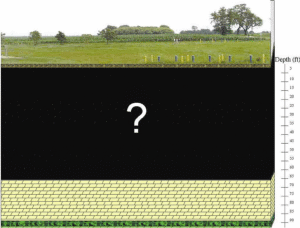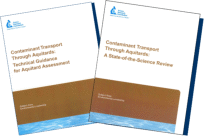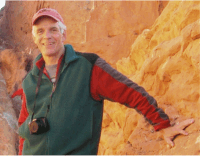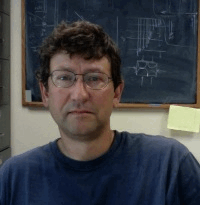
HYDROGEOLOGY OF AQUITARDS AND LOW-PERMEABILITY MATERIALS: Part 1:
Analysis of Aquitard Integrity
 We face a common problem: how many times have you learned of a shallow groundwater contamination problem and heard someone say "We don't have to worry about the deep aquifer, it is protected by an overlying aquitard"?
We face a common problem: how many times have you learned of a shallow groundwater contamination problem and heard someone say "We don't have to worry about the deep aquifer, it is protected by an overlying aquitard"?
How many times have you seen cross sections showing that downward migration of contaminants stops at a clay or shale layer? Have you ever really investigated these aquitards? How do you know they are effective barriers to contaminant movement?
Aquitards are critically important for understanding groundwater protection, drinking water supplies, and contaminant movement. Although aquitards may seem to make up only minor parts of hydrostratigraphic sequences they commonly control the overall groundwater flow system by influencing recharge, discharge, vertical head distributions, groundwater flow paths, and contaminant migration. During this 2-part webinar series, you will:
- Discover the unique hydraulic properties of low-permeability units.
- Learn about recent advances for testing aquitard integrity and apply it to your monitoring or ground water supply protection program.
- Avoid common mistakes related to characterizing ground water movement and contaminant pathways in low-permeability units.
Both unconsolidated and bedrock aquitards share inherent low hydraulic conductivities, but approaches and field methods for characterizing each type can be completely different. This 2-part webinar series will unravel the complexity of aquitards and their hydrogeologic and hydraulic relationships.
Applications:
- Hydrogeologic Characterization
- Environmental Site Investigation
- Remediation
- Water Supply
- Engineering Design
Highlights from Part One include:
- Aquifers and Aquitards: the importance of aquitards in all groundwater projects
- Definitions and basic categories of aquitards
- Hydrostratigraphic relationships and hydrogeologic context
- Definitions of aquitard integrity
- Keys to aquitard evaluation
- Defining the water table in low-permeability settings
- Do's and Don't's of monitoring aquitards
- How aquitards control groundwater flow system
Highlights from Part Two include:
- Summary of aquitard hydraulics
- Vertical vs. horizontal gradients: deciphering relationships
- How aquitards refract groundwater flow lines
- Diagnostic plots of hydraulic head profiles
- Relationships between hydraulic gradients, hydraulic conductivity, and groundwater flow rates
- Effects of transient conditions
- Evidence for (and against) perched conditions
- Example problem
Protect yourself, your company and your clients by learning how to assess which parts of the formation control aquitard integrity. The simple key to these concepts is correctly evaluating aquitard integrity.
Discover these hydrogeologic tools that are found no where else on the web.
Attendees are invited to actively participate during this live and interactive on-line web seminar. Discussion is planned following the webinar for those who want to continue the session. Bring your questions to the webinar and present them to the instructor and other participants for exploring the best solution.
| Fee: |
299.00 USD Per Computer Site (unlimited participants per site)
249.00 USD Per Computer Site (unlimited participants per site)
when Members also register for the following Webinar:

(discount will be applied during checkout when both are in your cart)
Pay one site registration fee and an unlimited number of participants from your organization can attend at that site.
|
| Instructors: |
Ken Bradbury, Ph.D., PG Program Leader and Hydrogeologist and David Hart, Ph.D., PG, Hydrogeologist
|
| Handouts: |
Copy of Webinar Slides (pdf)
Record of Attendance Form (pdf)
|
| Duration: |
1.5 hours plus Q&A
(no restrictions on time limit for extra Q&A!)
|
Professional
Development: |
Earn 1.5 Professional Development Hours (1.5 PDH)
 |
Attendees receive complimentary access copies to these two publications:
 |
- Contaminant Transport Through Aquitards:
Technical Guidance for Aquitard Assessment
and
- Contaminant Transport Through Aquitards:
A State of the Science Review
|
Cherry, J.A., B.L. Parker, K.R. Bradbury, T.T. Eaton, M.B. Gotkowitz, D.J. Hart, and M.A. Borchardt. 2006. Contaminant Transport Through Aquitards: A State-of-the-Science Review. . Published by American Water Works Association (AWWA) Research Foundation, and International Water Well Association (IWA) Publishing.
Bradbury, K,R, M.B. Gotkowitz, D.J. Hart, T.T. Eaton, J.A. Cherry, P,L. Parker, and M.A. Borchardt. 2006. Contaminant Transport Through Aquitards: Technical Guidance for Aquitard Assessment. Published by American Water Works Association (AWWA) Research Foundation, and International Water Well Association (IWA) Publishing.
|
A Record of Attendance Form is included free with each webinar for your record keeping and individual PDH verification. We ask your on-site coordinator to return the completed and signed copy of the Form to us following the webinar for (1) maintaining a separate copy as a service to attendees and (2) forwarding to NIU confirming attendance for those who order certificates.
Attendees may also order an official a Course Completion Certificate from Northern Illinois University for a small administrative fee. The Certificate is optional and may be ordered separately following the webinar to confirm your attendance and showcase the certificate on your office wall. Instructions for ordering certificates are given during the webinar.

* This webinar is eligible for the 'BUY THREE, GET THREE' discount; however the two-part webinar series discount shown above cannot be combined with it.
Attendees will be invited to actively participate during this live and interactive on-line web seminar. Discussion is planned following the webinar for those who want to continue the session. Bring your questions to the webinar and present them to the instructor and other participants for exploring the best solution.
Instructors Bio
Kenneth Bradbury, PhD, PG
( http://www.uwex.edu/wgnhs/staff_krb.htm )
 Dr. Kenneth Bradbury is Wisconsin's State Geologist and Director of the Wisconsin Geological and Natural History Survey, UW-Madison Division of Extension. Ken is a hydrogeologist who has worked and published on groundwater issues in Wisconsin since 1982, with a focus on applied problems. His research has included investigations of virus transport in groundwater, groundwater flow in fractured rocks, aquitard hydrogeology, groundwater recharge processes, wellhead protection, regional groundwater simulation, and the hydrogeology of glacial deposits.
Dr. Kenneth Bradbury is Wisconsin's State Geologist and Director of the Wisconsin Geological and Natural History Survey, UW-Madison Division of Extension. Ken is a hydrogeologist who has worked and published on groundwater issues in Wisconsin since 1982, with a focus on applied problems. His research has included investigations of virus transport in groundwater, groundwater flow in fractured rocks, aquitard hydrogeology, groundwater recharge processes, wellhead protection, regional groundwater simulation, and the hydrogeology of glacial deposits.
He received his B.A. from Ohio Wesleyan University, where he majored in geology, then earned a Master's degree from Indiana University. He received his PhD from the UW-Madison Department of Geology in 1982.
Ken is an affiliate faculty member in the UW-Madison Department of Geoscience and the Nelson Institute at UW-Madison. He is a Fellow in the Geological Society of America and is active in the Association of American State Geologists. Ken has served on the Water Science and Technology Board of the National Academy of Sciences and on committees advising the US Geological Survey.
Dave Hart PhD, PG
 Dave Hart is a hydrogeologist/geophysicist with the Wisconsin Geological and Natural History Survey and an associate professor at the University of Wisconsin-Extension.
Dave Hart is a hydrogeologist/geophysicist with the Wisconsin Geological and Natural History Survey and an associate professor at the University of Wisconsin-Extension.
Dave's applied research includes regional groundwater flow and recharge in southeastern Wisconsin, near-surface geophysics, and measurement of porosities and permeabilities in aquifers and aquitards. Prior to joining the university, he served as a hydrogeologist with Eder Associates. He is an associate editor for Ground Water and past president of the AWRA - Wisconsin Section.